This presentaion is available at the following URL as slides and a Jupyter notebook at the following URLs:
http://yt-project.org/pitp2016_demo/yt_tutorial.slides.html
http://yt-project.org/pitp2016_demo/yt_tutorial.ipynb
The data I use in this presentation are available at the following URL:
http://yt-project.org/pitp2016_demo/data
The example notebooks I'll be working through in a focus session are available here:
yt is a framework for working with the ouputs of simulation codes¶
visualization¶
- slices
- projections
- volume rendering
- phase diagrams
analysis¶
- data selection and derived quantities
- low-level data inspection
- profiling (how does a quantity vary with radius? density?)
- and much more...
yt supports many production astrophysical simulation codes¶
- SPH (Gadget, Gasoline, Tipsy, ...)
- Patch AMR (Enzo, Athena, Chombo, ...)
- Octree AMR (FLASH, ART, ...)
- Unstructured Mesh (Moab, Exodus II, ...)
yt runs on a variety of platforms¶
- Operating systems: Linux, macOS, Windows (including the new Bash on Windows!)
- Runs on everything from laptops (e.g., this one) to supercomputers (e.g., NASA's Pleiades)
- Currently runs in Python 2.7 and 3.5
- Source installs and binaries are available
Developed by a global team of astrophysics researchers to solve their real-world problems.¶
| Tom Abel | Andrew Cunningham | Cameron Hummels | Michael Kuhlen | Desika Narayanan | Hsi-Yu Schive | Ting-Wai To |
| Gabriel Altay | Bili Dong | Suoqing Ji | Meagan Lang | Kaylea Nelson | Anthony Scopatz | Joseph Tomlinson |
| Kenza Arraki | Nicholas Earl | Allyson Julian | Eve Lee | Brian O'Shea | Noel Scudder | Stephanie Tonnesen |
| Kirk Barrow | Hilary Egan | Anni Järvenpää | Doris Lee | J.S. Oishi | Sam Skillman | Matthew Turk |
| Ricarda Beckmann | Rasmi Elasmar | Christian Karch | Sam Leitner | JC Passy | Stephen Skory | Casey W. Stark |
| Elliott Biondo | Daniel Fenn | Max Katz | Stuart Levy | John Regan | Aaron Smith | Miguel de Val-Borro |
| Alex Bogert | John Forbes | BW Keller | Yuan Li | Mark Richardson | Britton Smith | Rick Wagner |
| Robert Bradshaw | Sam Geen | Ji-hoon Kim | Joshua Moloney | Sherwood Richers | Geoffrey So | Mike Warren |
| Yi-Hao Chen | Adam Ginsburg | Steffen Klemer | Christopher Moody | Thomas Robitaille | Antoine Strugarek | Andrew Wetzel |
| Pengfei Chen | Nathan Goldbaum | Fabian Koller | Stuart Mumford | Anna Rosen | Elizabeth Tasker | John Wise |
| David Collins | Eric Hallman | Kacper Kowalik | Andrew Myers | Chuck Rozhon | Benjamin Thompson | Michael Zingale |
| Brian Crosby | David Hannasch | Mark Krumholz | Jill Naiman | Douglas Rudd | Robert Thompson | John ZuHone |
from __future__ import print_function
import warnings
warnings.filterwarnings('ignore')
from IPython.display import IFrame
IFrame('http://yt-project.org/docs/dev/reference/code_support.html', width=960, height=600)
Sample datasets loadable by yt¶
IFrame('http://yt-project.org/data', width=700, height=500)
Eulerian, gridded, AMR/SMR data vs. Lagrangian, particle-based, SPH data¶
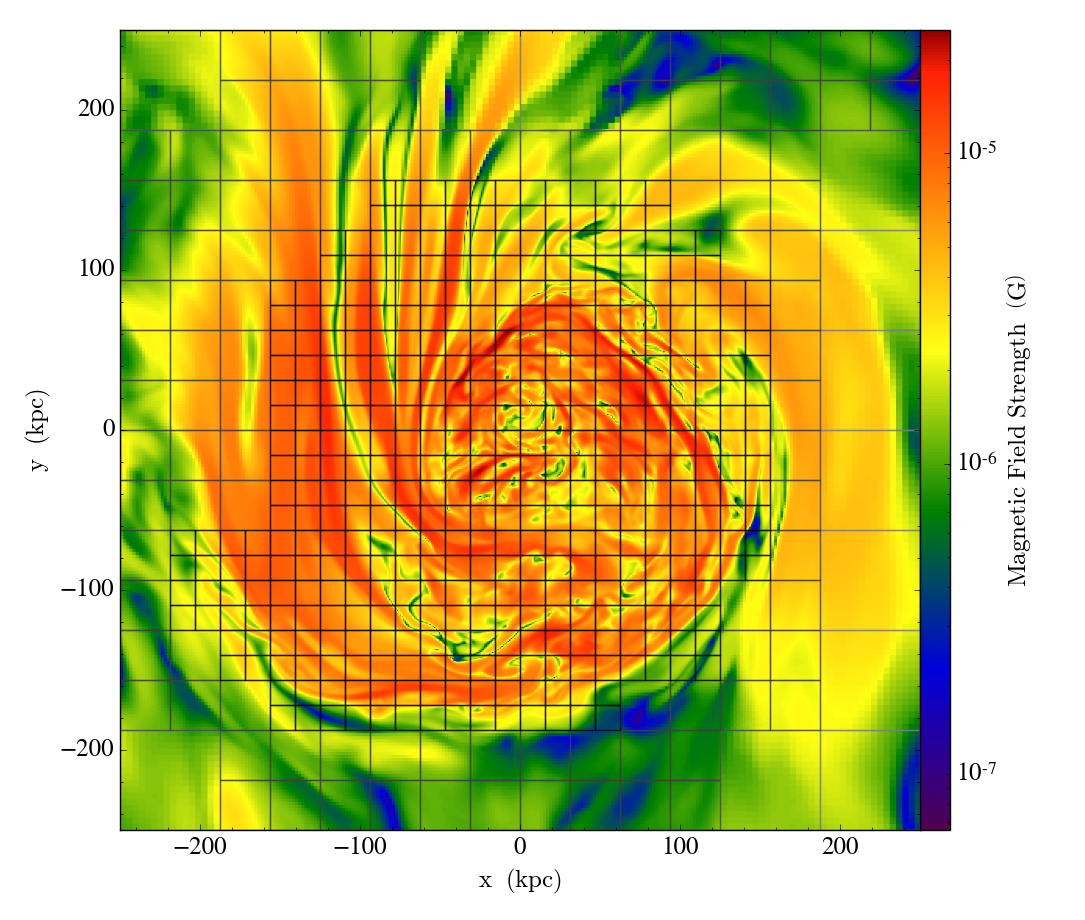
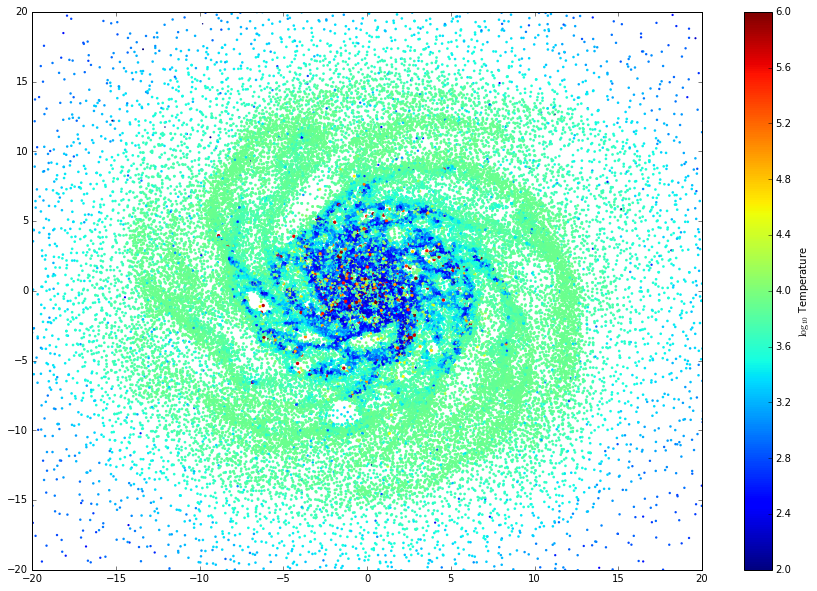
Data on disk has no inherent physical meaning¶
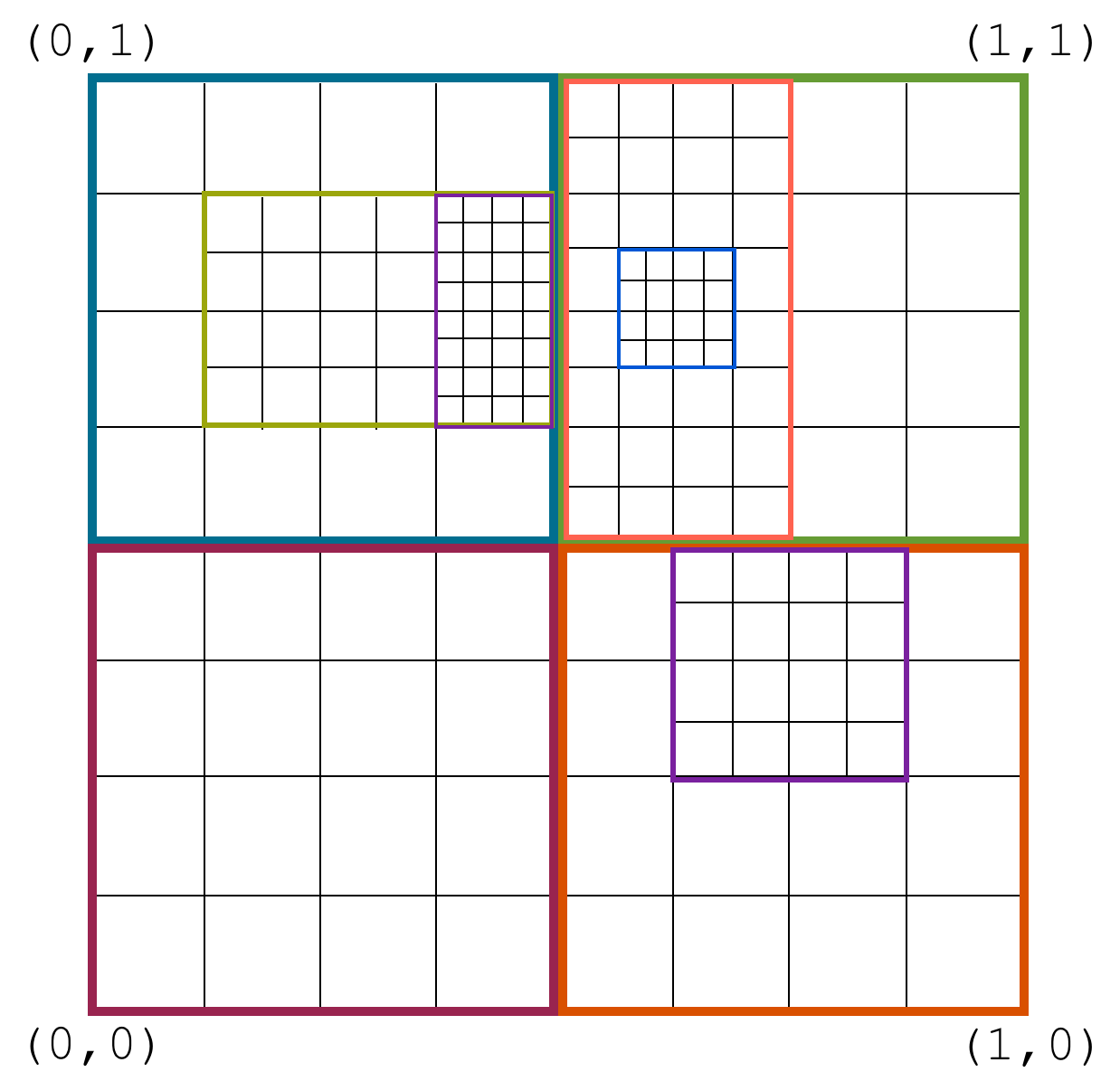
yt lets you think about the data using a physically motivated interface¶
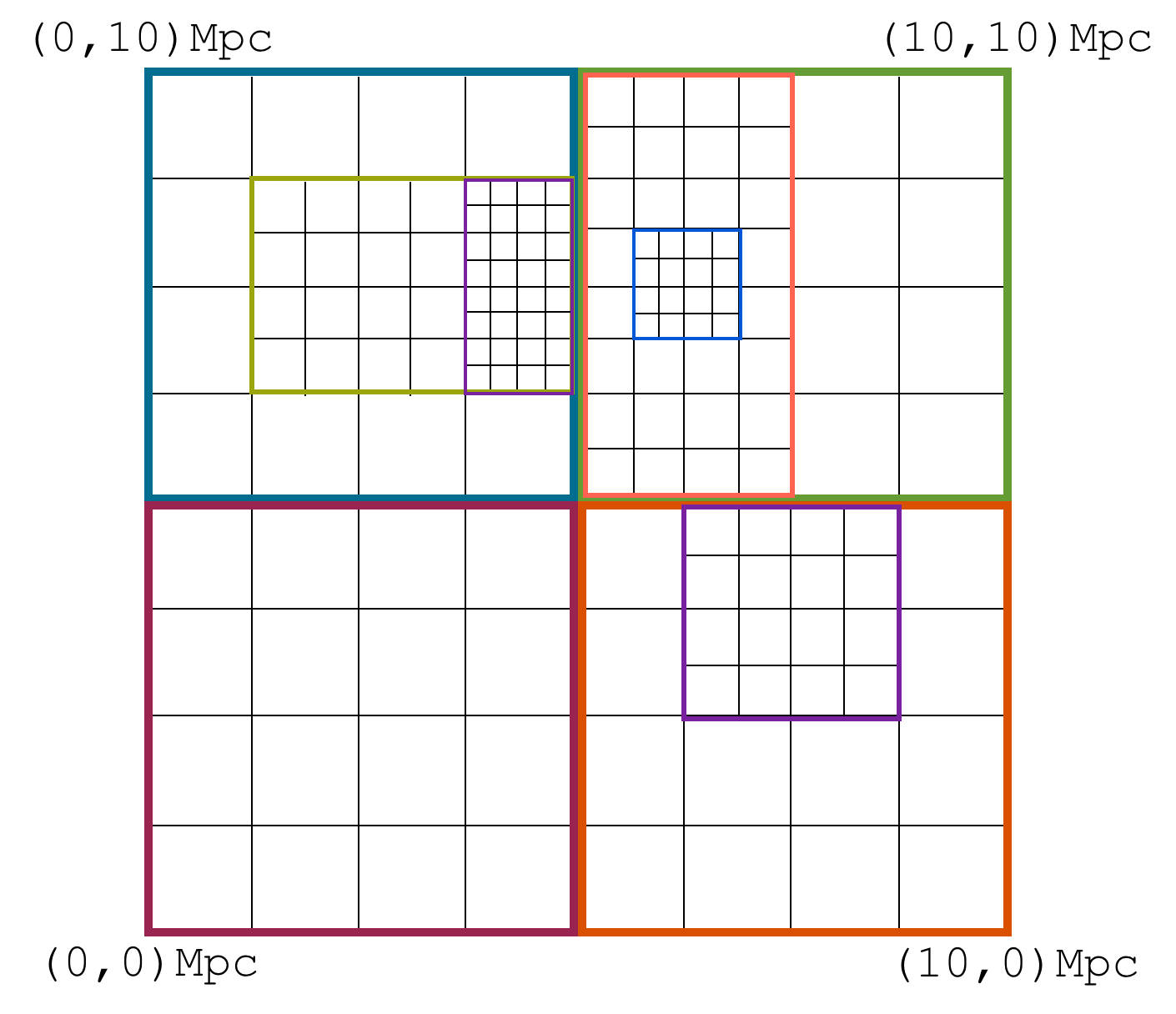
- Data Objects
- Fields
- Units
- Derived Quantities
yt lets you think about the data using a physically motivated interface¶
import yt
ds = yt.load('data/DD0046/DD0046')
yt : [INFO ] 2016-07-18 15:08:59,770 Parameters: current_time = 229.70846991283 yt : [INFO ] 2016-07-18 15:08:59,771 Parameters: domain_dimensions = [32 32 32] yt : [INFO ] 2016-07-18 15:08:59,773 Parameters: domain_left_edge = [ 0. 0. 0.] yt : [INFO ] 2016-07-18 15:08:59,775 Parameters: domain_right_edge = [ 1. 1. 1.] yt : [INFO ] 2016-07-18 15:08:59,777 Parameters: cosmological_simulation = 1 yt : [INFO ] 2016-07-18 15:08:59,778 Parameters: current_redshift = 2.2204460492503e-16 yt : [INFO ] 2016-07-18 15:08:59,780 Parameters: omega_lambda = 0.732 yt : [INFO ] 2016-07-18 15:08:59,781 Parameters: omega_matter = 0.268 yt : [INFO ] 2016-07-18 15:08:59,782 Parameters: hubble_constant = 0.704
Allowing you to forget about what your data looks like as a file format¶
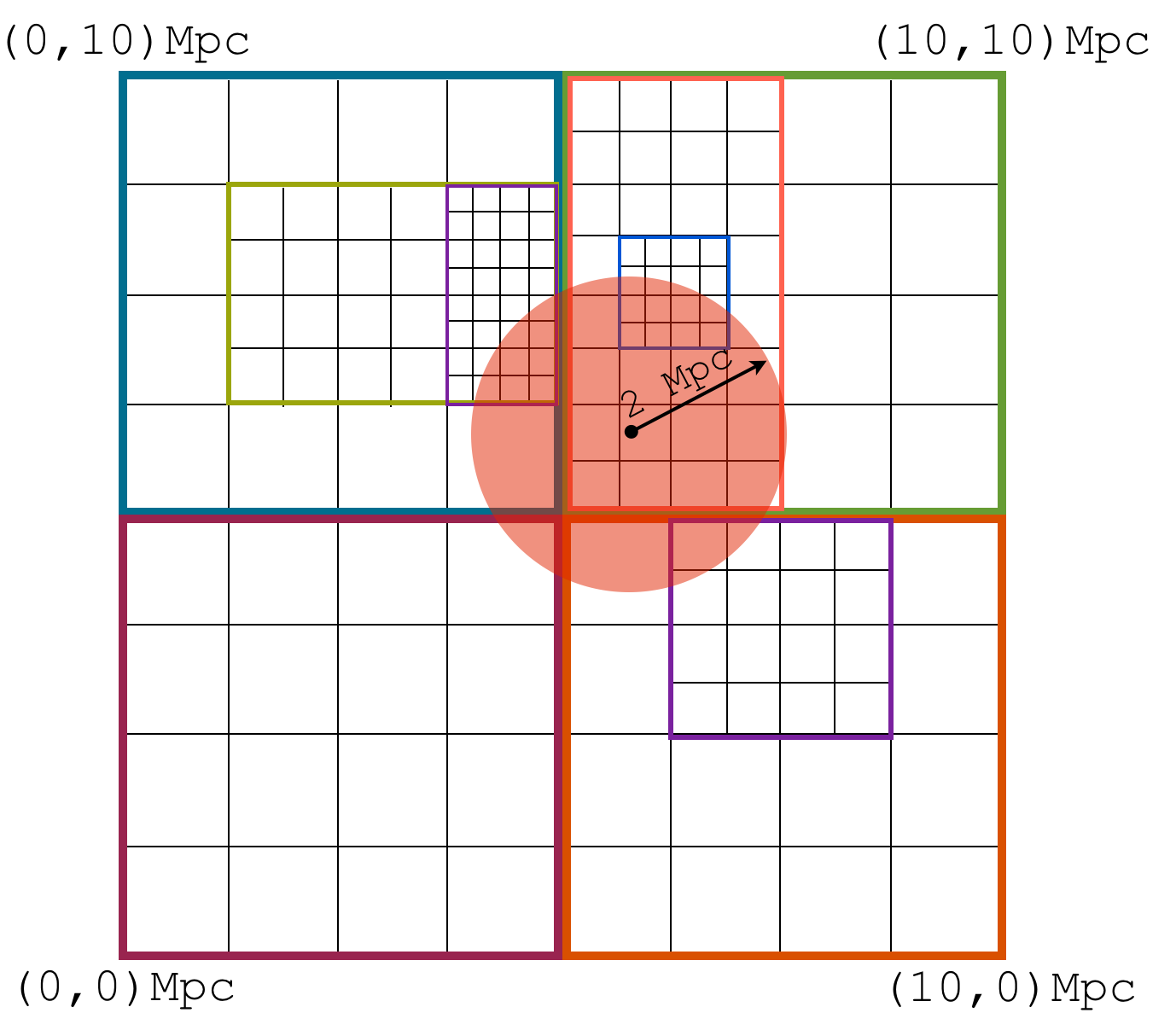
And select only the data you want to select¶

Data Objects¶
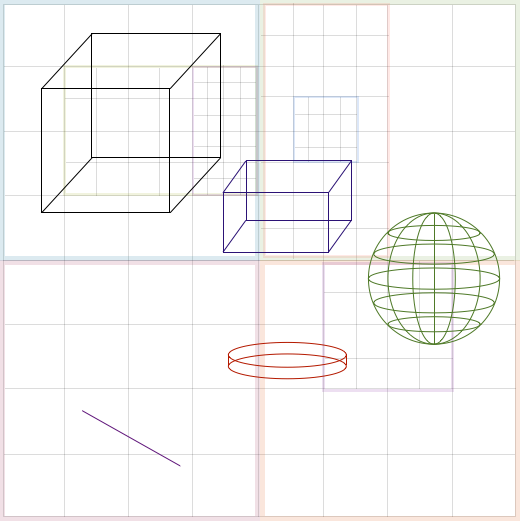
Physical objects to select data are called "data objects"¶

sp = ds.sphere("max", (2.0, "Mpc"))
Parsing Hierarchy : 100%|██████████| 124/124 [00:00<00:00, 14830.58it/s] yt : [INFO ] 2016-07-18 15:08:59,844 Gathering a field list (this may take a moment.) yt : [INFO ] 2016-07-18 15:09:01,917 Max Value is 1.12632e-26 at 0.4624023437500000 0.2124023437500000 0.5756835937500000
yt natively deals with multiresolution data¶
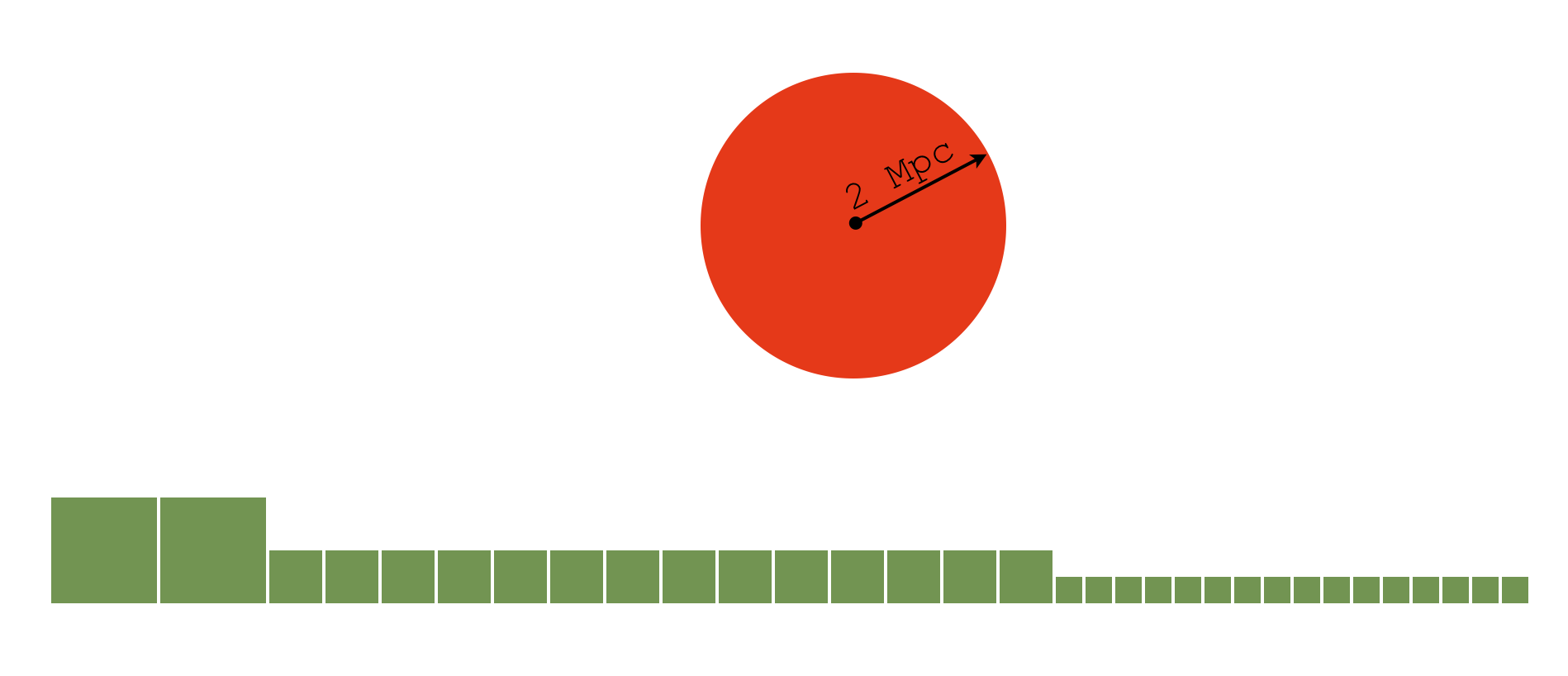
Data from each selected cell is returned as a flat, 1D array, with unit metadata attached¶

print(sp['density'])
[ 3.77609805e-31 3.85824291e-31 3.69230079e-31 ..., 1.24169320e-29 2.52070647e-30 1.55137848e-29] g/cm**3
Data objects can be queried for many fields¶
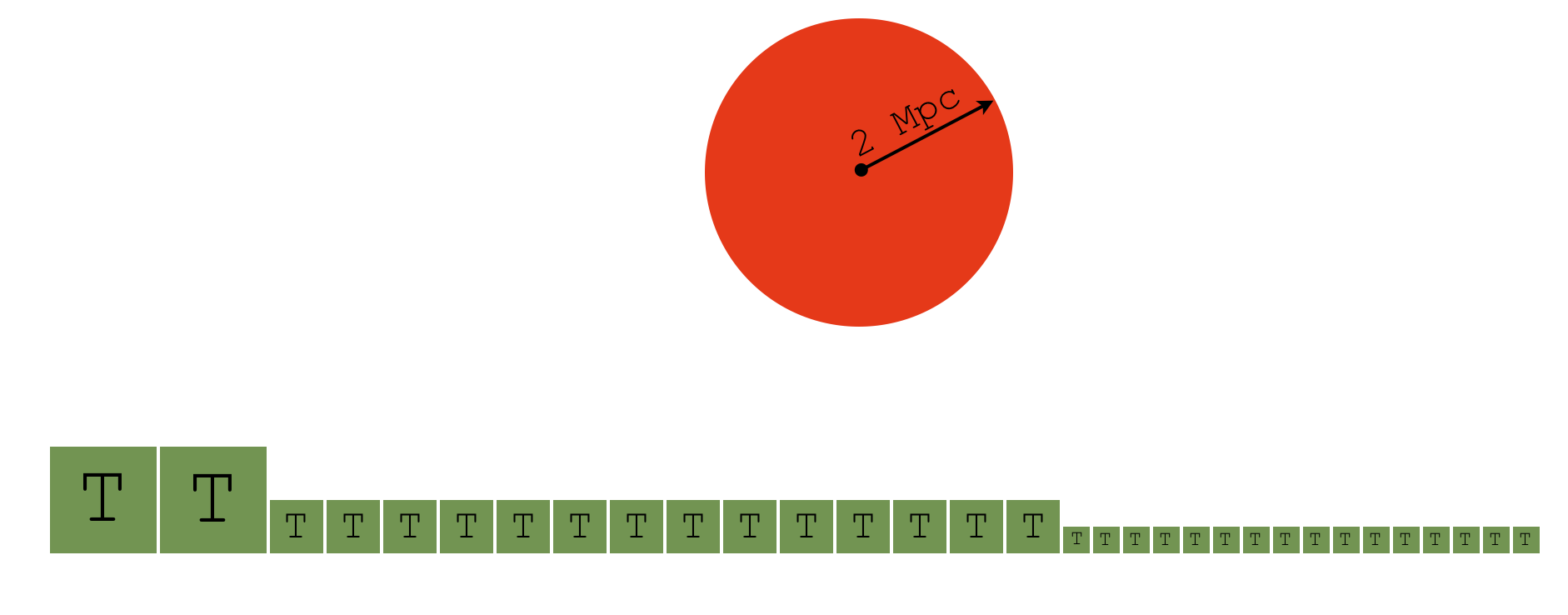
print(sp['temperature'])
[ 1676099.96624084 3020864.07440875 3031480.1098988 ..., 343977.59450144 865379.75614703 750720.84717605] K
Spatial information is not lost¶

sp['x']
YTArray([ 0.42578125, 0.42578125, 0.42578125, ..., 0.4609375 ,
0.4609375 , 0.4765625 ]) code_length
sp['x'].in_units('kpc')
YTArray([ 19353.69318182, 19353.69318182, 19353.69318182, ...,
20951.70454545, 20951.70454545, 21661.93181818]) kpc
Spatial information is not lost¶
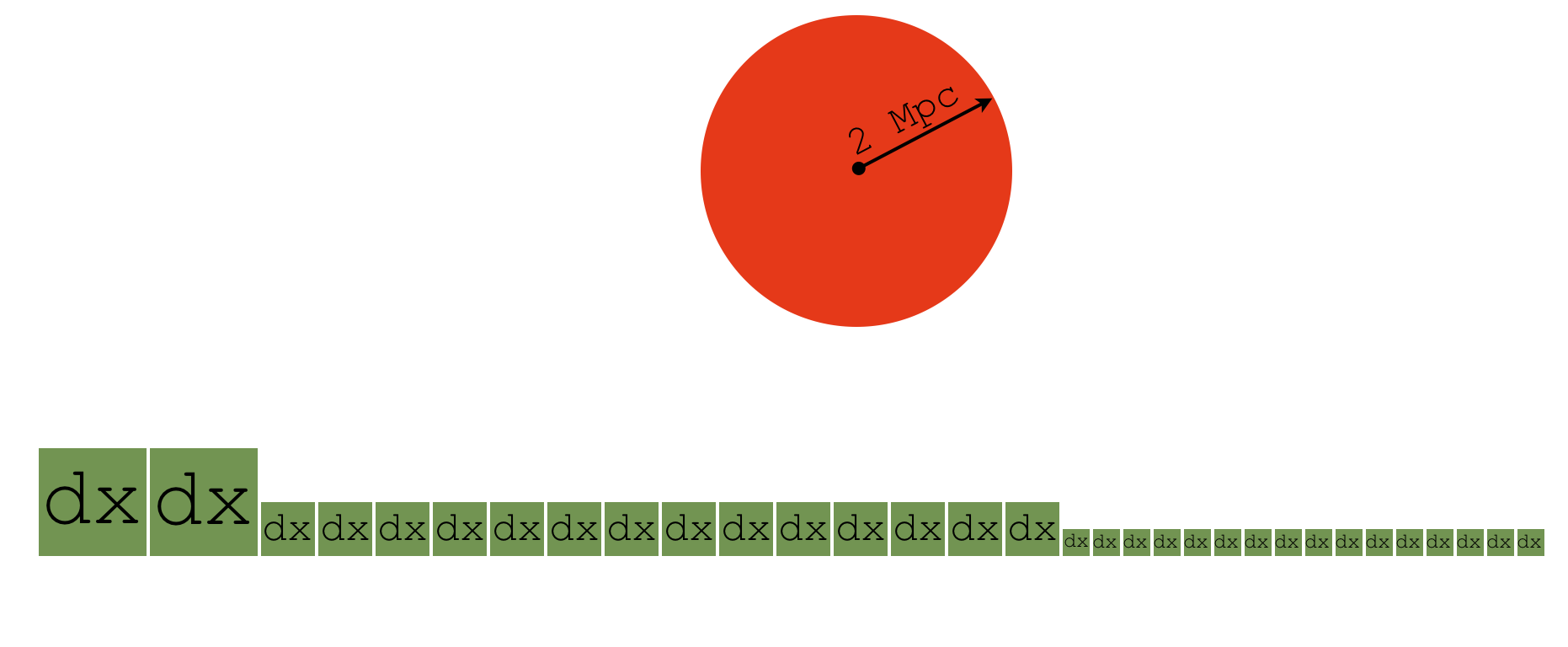
import numpy as np
np.unique(sp['dx']).in_units('kpc')
YTArray([ 44.38920455, 88.77840909, 177.55681818, 355.11363636,
710.22727273]) kpc
IFrame("http://yt-project.org/doc/analyzing/objects.html#available-objects", width=700, height=600)
import yt.units as u
ad = ds.all_data()
box = ds.box(ds.domain_left_edge + 500*u.kpc, ds.domain_right_edge - 500*u.kpc)
sp = ds.sphere(ds.domain_center, 500*u.kpc)
disk = ds.disk(ds.domain_center, [0, 0, 1], 500*u.kpc, 100*u.kpc)
ray = ds.ray(ds.domain_left_edge, ds.domain_right_edge)
Fields¶
Data objects can be queried for many fields¶
from pprint import pprint
# fields that are defined in the on-disk data file
pprint(ds.field_list)
[('all', 'creation_time'),
('all', 'dynamical_time'),
('all', 'metallicity_fraction'),
('all', 'particle_index'),
('all', 'particle_mass'),
('all', 'particle_position_x'),
('all', 'particle_position_y'),
('all', 'particle_position_z'),
('all', 'particle_type'),
('all', 'particle_velocity_x'),
('all', 'particle_velocity_y'),
('all', 'particle_velocity_z'),
('enzo', 'Dark_Matter_Density'),
('enzo', 'Density'),
('enzo', 'Electron_Density'),
('enzo', 'GasEnergy'),
('enzo', 'HII_Density'),
('enzo', 'HI_Density'),
('enzo', 'HeIII_Density'),
('enzo', 'HeII_Density'),
('enzo', 'HeI_Density'),
('enzo', 'Metal_Density'),
('enzo', 'Temperature'),
('enzo', 'TotalEnergy'),
('enzo', 'x-velocity'),
('enzo', 'y-velocity'),
('enzo', 'z-velocity'),
('io', 'creation_time'),
('io', 'dynamical_time'),
('io', 'metallicity_fraction'),
('io', 'particle_index'),
('io', 'particle_mass'),
('io', 'particle_position_x'),
('io', 'particle_position_y'),
('io', 'particle_position_z'),
('io', 'particle_type'),
('io', 'particle_velocity_x'),
('io', 'particle_velocity_y'),
('io', 'particle_velocity_z')]
Data objects can be queried for many fields¶
# fields that yt can calculate given the fields in ds.field_list
# (only showing gas fields to fit on one screen)
pprint([f for f in ds.derived_field_list if f[0]=='gas'][:20])
[('gas', 'El_density'),
('gas', 'El_fraction'),
('gas', 'El_mass'),
('gas', 'El_number_density'),
('gas', 'H_density'),
('gas', 'H_fraction'),
('gas', 'H_mass'),
('gas', 'H_nuclei_density'),
('gas', 'H_number_density'),
('gas', 'H_p0_density'),
('gas', 'H_p0_fraction'),
('gas', 'H_p0_mass'),
('gas', 'H_p0_number_density'),
('gas', 'H_p1_density'),
('gas', 'H_p1_fraction'),
('gas', 'H_p1_mass'),
('gas', 'H_p1_number_density'),
('gas', 'He_density'),
('gas', 'He_fraction'),
('gas', 'He_mass')]
Particle fields¶
pprint([f for f in ds.field_list if f[0]=='io'])
[('io', 'creation_time'),
('io', 'dynamical_time'),
('io', 'metallicity_fraction'),
('io', 'particle_index'),
('io', 'particle_mass'),
('io', 'particle_position_x'),
('io', 'particle_position_y'),
('io', 'particle_position_z'),
('io', 'particle_type'),
('io', 'particle_velocity_x'),
('io', 'particle_velocity_y'),
('io', 'particle_velocity_z')]
ad = ds.all_data()
print(ad['io', 'particle_position'])
print(ad['io', 'particle_mass'])
[[ 0.99917849 0.99302715 0.04505799] [ 0.97151599 0.99000909 0.04001278] [ 0.92810786 0.96941202 0.03330838] ..., [ 0.61380668 0.84492898 0.11017318] [ 0.61006628 0.84046116 0.11218501] [ 0.60696932 0.84205101 0.11330456]] code_length [ 2.54958423e-05 2.54958423e-05 2.54958423e-05 ..., 2.54958423e-05 2.54958423e-05 2.54958423e-05] code_mass
Deposit Fields¶
pprint([f for f in ds.derived_field_list if f[0]=='deposit'])
[('deposit', 'all_cic'),
('deposit', 'all_cic_velocity_x'),
('deposit', 'all_cic_velocity_y'),
('deposit', 'all_cic_velocity_z'),
('deposit', 'all_count'),
('deposit', 'all_density'),
('deposit', 'all_mass'),
('deposit', 'all_nn_velocity_x'),
('deposit', 'all_nn_velocity_y'),
('deposit', 'all_nn_velocity_z'),
('deposit', 'io_cic'),
('deposit', 'io_cic_velocity_x'),
('deposit', 'io_cic_velocity_y'),
('deposit', 'io_cic_velocity_z'),
('deposit', 'io_count'),
('deposit', 'io_density'),
('deposit', 'io_mass'),
('deposit', 'io_nn_velocity_x'),
('deposit', 'io_nn_velocity_y'),
('deposit', 'io_nn_velocity_z')]
Derived Fields: create new fields by defining a python function¶
from yt.units import kboltz, mh
def my_entropy(field, data):
return (kboltz * data['temperature'] / data['number_density']**(2./3.))
ds.add_field('entropy', function=my_entropy, units="keV*cm**2")
Derived Fields: create new fields by defining a python function¶

sp['entropy']
YTArray([ 9.8712904 , 10.05900208, 116.28453857, 103.34896303,
9.05717995, 9.63822214, 109.85636122, 96.60393576]) cm**2*keV
yt employs a field "democracy"¶
- Fields on-disk and derived fields are treated in exactly the same way
- Accessed the same way, visualized the same way
- On-disk fields are mapped to a set of common fields, to faciliate using the same scripts across different datasets
print(sp["gas","density"])
[ 9.72796224e-32 7.51133575e-32 1.11774404e-30 7.88742157e-31 1.11512078e-31 9.97278399e-32 1.03069070e-30 9.20236791e-31] g/cm**3
print(sp["enzo","Density"]) # These are the same field, just aliased
[ 0.03898174 0.03009931 0.44790066 0.31606353 0.04468495 0.03996279 0.41301678 0.36875586] code_mass/code_length**3
print(sp["enzo","Density"].in_cgs())
[ 9.72796224e-32 7.51133575e-32 1.11774404e-30 7.88742157e-31 1.11512078e-31 9.97278399e-32 1.03069070e-30 9.20236791e-31] g/cm**3
Units¶
We've already seen how data objects return fields as unit-aware NumPy arrays¶

pressure = sp['density']*sp['temperature']*kboltz/(0.6*mh)
pressure.in_units('Pa')
YTArray([ 2.29874917e-21, 1.52229231e-21, 1.58431101e-18,
7.87551706e-19, 2.64815892e-21, 2.33940537e-21,
1.30753605e-18, 9.51864956e-19]) Pa
pressure.in_units('dyne/cm**2')
YTArray([ 2.29874917e-20, 1.52229231e-20, 1.58431101e-17,
7.87551706e-18, 2.64815892e-20, 2.33940537e-20,
1.30753605e-17, 9.51864956e-18]) dyne/cm**2
yt has very flexible handling for units and unit conversions¶
rho = sp['density']
print (rho.in_units('g/cm**3'))
print ()
print (rho.in_units('Msun/kpc**3'))
print ()
print (rho.in_units('code_mass/code_length**3')) # What's this?
[ 9.72796224e-32 7.51133575e-32 1.11774404e-30 7.88742157e-31 1.11512078e-31 9.97278399e-32 1.03069070e-30 9.20236791e-31] g/cm**3 [ 1.43736244 1.10984311 16.51531184 11.6541196 1.64765518 1.47353627 15.22904869 13.59702854] Msun/kpc**3 [ 0.03898174 0.03009931 0.44790066 0.31606353 0.04468495 0.03996279 0.41301678 0.36875586] code_mass/code_length**3
Shorthand conversions for different unit systems¶
# Methods for MKSA and cgs/Gaussian units
print(rho.in_mks())
print()
print(rho.in_cgs())
[ 9.72796224e-29 7.51133575e-29 1.11774404e-27 7.88742157e-28 1.11512078e-28 9.97278399e-29 1.03069070e-27 9.20236791e-28] kg/m**3 [ 9.72796224e-32 7.51133575e-32 1.11774404e-30 7.88742157e-31 1.11512078e-31 9.97278399e-32 1.03069070e-30 9.20236791e-31] g/cm**3
Other unit systems are available¶
print(list(yt.unit_system_registry.keys()))
['cgs-ampere', 'cgs', 'imperial', 'DD0046', 'mks', 'geometrized', 'planck', 'galactic', 'solar']
yt.unit_system_registry['mks']
mks Unit System Base Units: mass: kg time: s length: m temperature: K current_mks: A angle: rad Other Units: energy: J specific_energy: J/kg pressure: Pa force: N magnetic_field_mks: T charge_mks: C
Let's look at some of the unit systems¶
yt.unit_system_registry['imperial']
imperial Unit System Base Units: length: ft mass: lbm temperature: R time: s angle: rad Other Units: force: lbf energy: ft*lbf pressure: lbf/ft**2
yt.unit_system_registry['geometrized']
geometrized Unit System Base Units: length: l_geom mass: m_geom temperature: K time: t_geom angle: rad Other Units:
We can convert into these other systems, too¶
print(rho.in_base('imperial'))
print()
print(rho.in_base('galactic'))
print()
print(rho.in_base('geometrized'))
[ 6.07296843e-30 4.68917372e-30 6.97784806e-29 4.92395643e-29 6.96147163e-30 6.22580566e-30 6.43439185e-29 5.74485061e-29] lbm/ft**3 [ 1.43736244 1.10984311 16.51531184 11.6541196 1.64765518 1.47353627 15.22904869 13.59702854] Msun/kpc**3 [ 1.57485099e-49 1.21600334e-49 1.80950569e-48 1.27688753e-48 1.80525893e-49 1.61448496e-49 1.66857583e-48 1.48976300e-48] m_geom/l_geom**3
But don't do something silly!¶
T = sp['temperature']
T.convert_to_units('kpc') # oops
--------------------------------------------------------------------------- YTUnitConversionError Traceback (most recent call last) <ipython-input-32-919b53ddef1e> in <module>() ----> 1 T.convert_to_units('kpc') # oops /Users/jzuhone/Source/yt/yt/units/yt_array.py in convert_to_units(self, units) 467 468 """ --> 469 new_units = _unit_repr_check_same(self.units, units) 470 (conversion_factor, offset) = self.units.get_conversion_factor(new_units) 471 /Users/jzuhone/Source/yt/yt/units/yt_array.py in _unit_repr_check_same(my_units, other_units) 197 if not my_units.same_dimensions_as(other_units): 198 raise YTUnitConversionError( --> 199 my_units, my_units.dimensions, other_units, other_units.dimensions) 200 201 return other_units YTUnitConversionError: Unit dimensionalities do not match. Tried to convert between K (dim (temperature)) and kpc (dim (length)).
You can also make your own unitful arrays, and quantities too¶
from yt import YTArray, YTQuantity
a = YTArray(np.random.random(10), "kpc")
print(a)
[ 0.81955693 0.98290329 0.07128665 0.04860733 0.84772189 0.24895699 0.98488209 0.85199743 0.4395122 0.01294123] kpc
b = YTQuantity(1.0e-27, "erg/s/cm**2/steradian")
print(b)
1e-27 erg/(cm**2*s*steradian)
Other ways of using units¶
import yt.units as u
print(u.kpc)
1.0 kpc
x = np.array([4.,5.,6.])*u.kg*u.cm/u.s
print(x)
[ 4. 5. 6.] cm*kg/s
Physical Constants¶
from yt.units import G, kboltz, hbar
print(G)
print()
print(kboltz)
print()
print(hbar)
6.67384e-08 cm**3/(g*s**2) 1.3806488e-16 erg/K 1.0545717253362894e-27 erg*s
gal_system = yt.unit_system_registry['galactic']
print(gal_system.constants.G)
print()
print(gal_system.constants.kboltz)
print()
print(gal_system.constants.hbar)
4.498205661165364e-12 kpc**3/(Msun*Myr**2) 7.262444811589367e-66 Msun*kpc**2/(K*Myr**2) 1.7578093950982924e-90 Msun*kpc**2/Myr
Every dataset has a set of "code units"¶
for unit in ["length", "mass", "time", "velocity", "magnetic"]:
print("code_%s =" % unit, getattr(ds, unit+"_unit"))
code_length = 32.0 Mpccm/h code_mass = 6.885639111117815e+48 g code_time = 1898476477341437.0 s code_velocity = 1449234126.012771 cm/s code_magnetic = 0.0004137213258267729 gauss
You can create arrays and quantities with code units too, provided you use the dataset¶
v = ds.arr([1.0, 2.0, 3.0], "code_length/code_time")
print(v.in_units("km/s"))
[ 738792.78219099 1477585.56438199 2216378.34657298] km/s
p = ds.quan(3.0e-3, "code_mass/code_time**2/code_length")
print(p.in_units("keV/cm**3"))
0.02550450106560087 keV/cm**3
Basic arithmetic and most NumPy functions work on unitful arrays¶
rho + 200*u.Msun/u.kpc**3
YTArray([ 1.36331310e-29, 1.36109648e-29, 1.46535955e-29,
1.43245936e-29, 1.36473635e-29, 1.36355793e-29,
1.45665421e-29, 1.44560882e-29]) g/cm**3
np.sqrt(rho)
YTArray([ 3.11896814e-16, 2.74068162e-16, 1.05723414e-15,
8.88111568e-16, 3.33934242e-16, 3.15797150e-16,
1.01522938e-15, 9.59289732e-16]) sqrt(g)/cm**(3/2)
rho*sp["velocity_x"]
YTArray([ 2.14988539e-24, 1.69476910e-24, 9.70718833e-24,
9.09023779e-24, 2.43511879e-24, 2.22425382e-24,
9.85462002e-24, 1.05188104e-23]) g/(cm**2*s)
But again, don't do something silly!¶
rho + sp["velocity_x"]
--------------------------------------------------------------------------- YTUnitOperationError Traceback (most recent call last) <ipython-input-45-b0098d433e74> in <module>() ----> 1 rho + sp["velocity_x"] /Users/jzuhone/Source/yt/yt/units/yt_array.py in __add__(self, right_object) 903 904 """ --> 905 ro = sanitize_units_add(self, right_object, "addition") 906 return super(YTArray, self).__add__(ro) 907 /Users/jzuhone/Source/yt/yt/units/yt_array.py in sanitize_units_add(this_object, other_object, op_string) 155 elif not np.any(this_object): 156 return ret --> 157 raise YTUnitOperationError(op_string, inp.units, ret.units) 158 ret = ret.in_units(inp.units) 159 else: YTUnitOperationError: The addition operator for YTArrays with units (g/cm**3) and (cm/s) is not well defined.
Derived Quantities¶
Derived quantities turn fields into single values¶
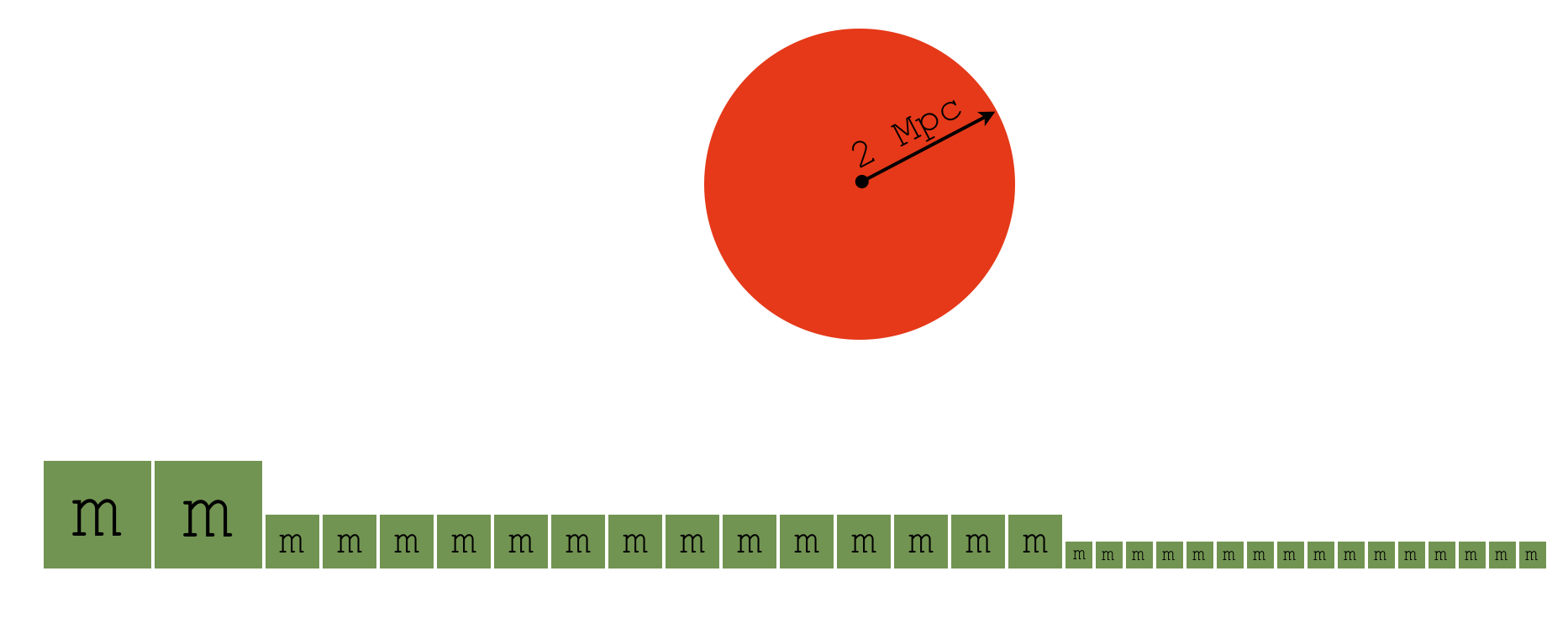
sp['cell_mass']
YTArray([ 8.19135097e+42, 6.32485878e+42, 9.41187216e+43,
6.64153876e+43, 9.38978327e+42, 8.39750112e+42,
8.67884668e+43, 7.74877856e+43]) g
Derived quantities turn fields into single values¶
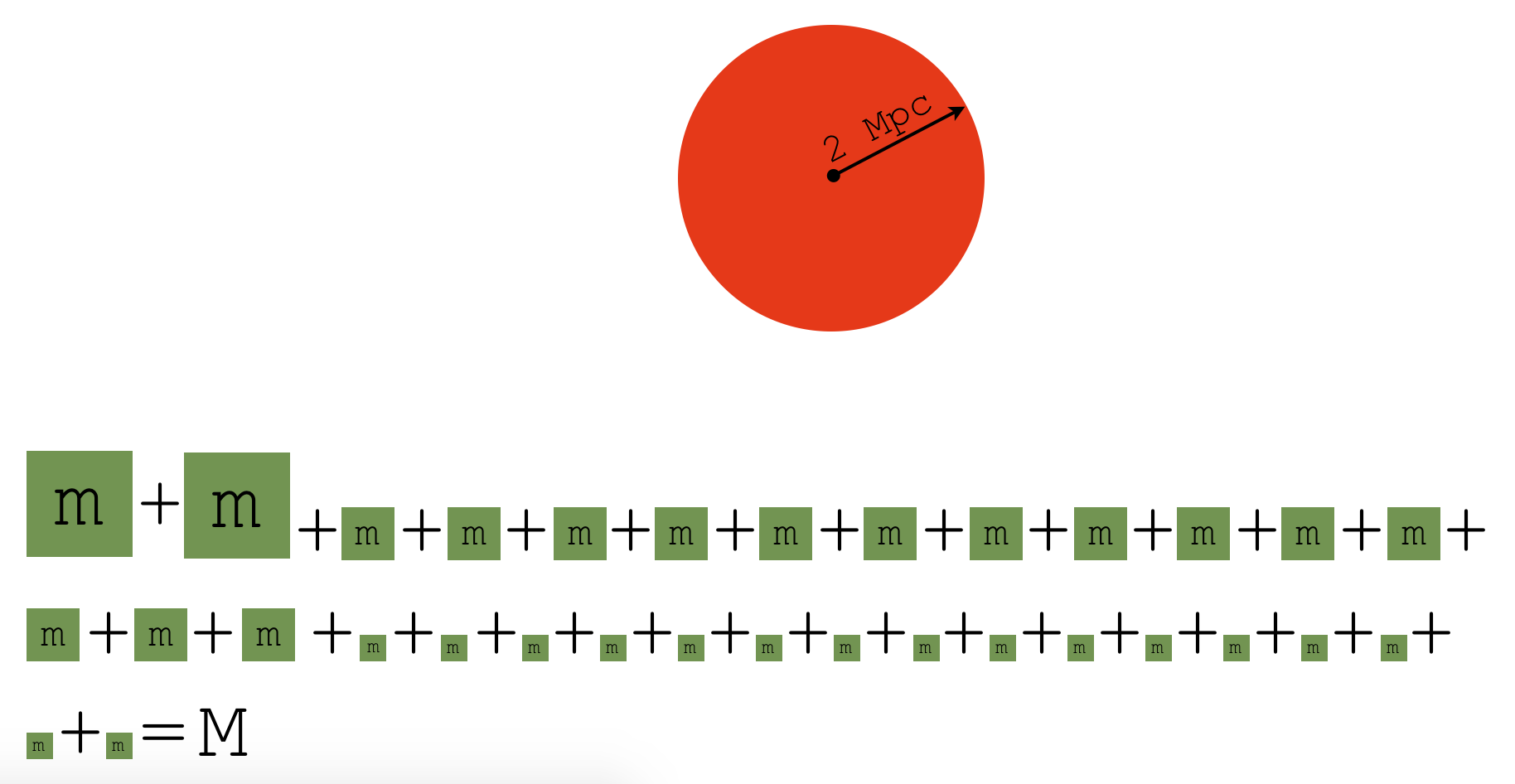
sp.quantities.total_quantity('cell_mass')
3.571138557332189e+44 g
sp.quantities.angular_momentum_vector()
YTArray([ -9.93000428e+29, -7.23255885e+30, -9.17649110e+30]) cm**2/s
IFrame("http://yt-project.org/docs/dev/analyzing/objects.html#available-derived-quantities", width=700, height=600)
NumPy-like operations¶
- yt has another way to create rectangular-shaped regions using NumPy-like syntax
- The resulting regions have useful NumPy-like operations
dd = ds.r[:,:,:] # A region containing all the data
print(dd.mean("density"))
print(dd.mean("temperature", weight="density"))
3.2359310861810075e-29 g/cm**3 4813733.901297271 K
dd.argmax("temperature")
(0.8046875 code_length, 0.8671875 code_length, 0.9609375 code_length)
dd.argmax("temperature", axis=["density", "radius"])
[9.122286925255487e-32 g/cm**3, 9.304984252044084e+25 cm]
NumPy-like operations¶
reg = ds.r[0.4:0.6,0.1:0.3,0.35:0.75] # subset of the domain in code units
reg.mean("density")
2.717166127977496e-28 g/cm**3
c = ds.domain_center
w = 5.0*u.Mpc
le = c-0.5*w
re = c+0.5*w
reg2 = ds.r[le[0]:re[0],le[1]:re[1],le[2]:re[2]] # subset of the domain using a left and right edge
reg2.mean("density")
5.233135741599468e-31 g/cm**3
Visualization and analysis¶
- SlicePlot, ProjectionPlot, ParticleProjectionPlot
- ProfilePlot, PhasePlot
- Slices, projections, profiles, covering grids, and fixed resolution buffers
SlicePlot¶
from yt import SlicePlot
slc = SlicePlot(ds, 'x', ('gas', 'density'), center='max')
yt : [INFO ] 2016-07-18 15:09:40,770 Max Value is 1.12632e-26 at 0.4624023437500000 0.2124023437500000 0.5756835937500000
yt : [INFO ] 2016-07-18 15:09:40,813 xlim = -0.287598 0.712402
yt : [INFO ] 2016-07-18 15:09:40,814 ylim = 0.075684 1.075684
yt : [INFO ] 2016-07-18 15:09:40,815 xlim = -0.287598 0.712402
yt : [INFO ] 2016-07-18 15:09:40,816 ylim = 0.075684 1.075684
yt : [INFO ] 2016-07-18 15:09:40,824 Making a fixed resolution buffer of (('gas', 'density')) 800 by 800
slc.show()
slc.set_origin('native')
ds2 = yt.load('data/virgo_novisc.0054.gdf')
slc2 = SlicePlot(ds2, 'z', ['magnetic_field_strength'],
width=(500, 'kpc'), center='c')
yt : [INFO ] 2016-07-18 15:09:43,360 Parameters: current_time = 2700.122
yt : [INFO ] 2016-07-18 15:09:43,361 Parameters: domain_dimensions = [256 256 256]
yt : [INFO ] 2016-07-18 15:09:43,362 Parameters: domain_left_edge = [-2. -2. -2.]
yt : [INFO ] 2016-07-18 15:09:43,363 Parameters: domain_right_edge = [ 2. 2. 2.]
yt : [INFO ] 2016-07-18 15:09:43,364 Parameters: cosmological_simulation = 0.0
yt : [INFO ] 2016-07-18 15:09:45,092 xlim = -0.250000 0.250000
yt : [INFO ] 2016-07-18 15:09:45,092 ylim = -0.250000 0.250000
yt : [INFO ] 2016-07-18 15:09:45,094 xlim = -0.250000 0.250000
yt : [INFO ] 2016-07-18 15:09:45,094 ylim = -0.250000 0.250000
yt : [INFO ] 2016-07-18 15:09:45,096 Making a fixed resolution buffer of (('gas', 'magnetic_field_strength')) 800 by 800
slc2.show()
slc.set_cmap('density', 'magma')
Plot callbacks¶
slc.annotate_grids()
slc2.annotate_magnetic_field()
slc2.annotate_clear()
slc2.annotate_streamlines('velocity_x', 'velocity_y')
Line integral convolution (talk to Suoqing Ji, who is here!)¶
slc2.annotate_clear()
slc2.annotate_line_integral_convolution('magnetic_field_x', 'magnetic_field_y')
slc.save('my_amazing_plot.eps')
yt : [INFO ] 2016-07-18 15:09:54,888 Saving plot my_amazing_plot.eps
['my_amazing_plot.eps']
slc.save('my_amazing_plot.png')
yt : [INFO ] 2016-07-18 15:09:55,491 Saving plot my_amazing_plot.png
['my_amazing_plot.png']
from yt.units import mp
import numpy as np
def _sound_speed(field, data):
return np.sqrt(5./3.*data['kT']/(0.6*mp))
def _mach_number(field, data):
return data["velocity_magnitude"]/data["speed_of_sound"]
ds2.add_field(('gas', 'speed_of_sound'), _sound_speed, units='cm/s', force_override=True)
ds2.add_field(('gas', 'mach'), _mach_number, units='', force_override=True)
slc = yt.SlicePlot(ds2, 'z', ["speed_of_sound"], width=(200., 'kpc'))
slc.set_unit('speed_of_sound', 'km/s')
slc.set_log('speed_of_sound', False)
slc.set_zlim('speed_of_sound', 600., 1000.)
yt : [INFO ] 2016-07-18 15:09:56,268 xlim = -0.100000 0.100000
yt : [INFO ] 2016-07-18 15:09:56,269 ylim = -0.100000 0.100000
yt : [INFO ] 2016-07-18 15:09:56,271 xlim = -0.100000 0.100000
yt : [INFO ] 2016-07-18 15:09:56,273 ylim = -0.100000 0.100000
yt : [INFO ] 2016-07-18 15:09:56,275 Making a fixed resolution buffer of (('gas', 'speed_of_sound')) 800 by 800
slc = yt.SlicePlot(ds2, 'z', ["mach"], width=(200., 'kpc'))
slc.set_log('mach', False)
slc.set_zlim('mach', 0.1, 0.8)
yt : [INFO ] 2016-07-18 15:09:58,165 xlim = -0.100000 0.100000
yt : [INFO ] 2016-07-18 15:09:58,165 ylim = -0.100000 0.100000
yt : [INFO ] 2016-07-18 15:09:58,167 xlim = -0.100000 0.100000
yt : [INFO ] 2016-07-18 15:09:58,168 ylim = -0.100000 0.100000
yt : [INFO ] 2016-07-18 15:09:58,169 Making a fixed resolution buffer of (('gas', 'mach')) 800 by 800
ProjectionPlot¶
from yt import ProjectionPlot
prj = ProjectionPlot(ds2, "z", 'density')
yt : [INFO ] 2016-07-18 15:10:21,566 Projection completed
yt : [INFO ] 2016-07-18 15:10:21,578 xlim = -2.000000 2.000000
yt : [INFO ] 2016-07-18 15:10:21,579 ylim = -2.000000 2.000000
yt : [INFO ] 2016-07-18 15:10:21,582 xlim = -2.000000 2.000000
yt : [INFO ] 2016-07-18 15:10:21,583 ylim = -2.000000 2.000000
yt : [INFO ] 2016-07-18 15:10:21,594 Making a fixed resolution buffer of (('gas', 'density')) 800 by 800
prj
prj.zoom(20)
yt : [INFO ] 2016-07-18 15:10:22,717 Making a fixed resolution buffer of (('gas', 'density')) 800 by 800
prj.zoom(3)
yt : [INFO ] 2016-07-18 15:10:23,386 Making a fixed resolution buffer of (('gas', 'density')) 800 by 800
ProjectionPlot(ds2, "z", 'density', width=(300.,"kpc"))
yt : [INFO ] 2016-07-18 15:10:42,553 Projection completed
yt : [INFO ] 2016-07-18 15:10:42,562 xlim = -0.150000 0.150000
yt : [INFO ] 2016-07-18 15:10:42,562 ylim = -0.150000 0.150000
yt : [INFO ] 2016-07-18 15:10:42,566 xlim = -0.150000 0.150000
yt : [INFO ] 2016-07-18 15:10:42,567 ylim = -0.150000 0.150000
yt : [INFO ] 2016-07-18 15:10:42,572 Making a fixed resolution buffer of (('gas', 'density')) 800 by 800
ProjectionPlot(ds2, "x", 'density', width=(300.,"kpc"))
yt : [INFO ] 2016-07-18 15:11:07,492 Projection completed
yt : [INFO ] 2016-07-18 15:11:07,501 xlim = -0.150000 0.150000
yt : [INFO ] 2016-07-18 15:11:07,501 ylim = -0.150000 0.150000
yt : [INFO ] 2016-07-18 15:11:07,504 xlim = -0.150000 0.150000
yt : [INFO ] 2016-07-18 15:11:07,505 ylim = -0.150000 0.150000
yt : [INFO ] 2016-07-18 15:11:07,509 Making a fixed resolution buffer of (('gas', 'density')) 800 by 800
ProjectionPlot(ds2, "y", 'density', width=(300.,"kpc"))
yt : [INFO ] 2016-07-18 15:11:27,796 Projection completed
yt : [INFO ] 2016-07-18 15:11:27,803 xlim = -0.150000 0.150000
yt : [INFO ] 2016-07-18 15:11:27,804 ylim = -0.150000 0.150000
yt : [INFO ] 2016-07-18 15:11:27,807 xlim = -0.150000 0.150000
yt : [INFO ] 2016-07-18 15:11:27,808 ylim = -0.150000 0.150000
yt : [INFO ] 2016-07-18 15:11:27,811 Making a fixed resolution buffer of (('gas', 'density')) 800 by 800
sp = ds.sphere("max", (5.0, 'Mpc'))
prj = ProjectionPlot(ds, "z", 'density', data_source=sp)
yt : [INFO ] 2016-07-18 15:11:29,133 Max Value is 1.12632e-26 at 0.4624023437500000 0.2124023437500000 0.5756835937500000
yt : [INFO ] 2016-07-18 15:11:29,153 Projection completed
yt : [INFO ] 2016-07-18 15:11:29,155 xlim = 0.000000 1.000000
yt : [INFO ] 2016-07-18 15:11:29,156 ylim = 0.000000 1.000000
yt : [INFO ] 2016-07-18 15:11:29,158 xlim = 0.000000 1.000000
yt : [INFO ] 2016-07-18 15:11:29,159 ylim = 0.000000 1.000000
yt : [INFO ] 2016-07-18 15:11:29,161 Making a fixed resolution buffer of (('gas', 'density')) 800 by 800
prj
ProjectionPlot(ds2, 2, 'kT', weight_field='density', width=(500, 'kpc'))
yt : [INFO ] 2016-07-18 15:11:56,385 Projection completed
yt : [INFO ] 2016-07-18 15:11:56,392 xlim = -0.250000 0.250000
yt : [INFO ] 2016-07-18 15:11:56,394 ylim = -0.250000 0.250000
yt : [INFO ] 2016-07-18 15:11:56,396 xlim = -0.250000 0.250000
yt : [INFO ] 2016-07-18 15:11:56,397 ylim = -0.250000 0.250000
yt : [INFO ] 2016-07-18 15:11:56,401 Making a fixed resolution buffer of (('gas', 'kT')) 800 by 800
ProjectionPlot(ds2, 'z', 'density', width=(500, 'kpc'), method='mip')
yt : [INFO ] 2016-07-18 15:12:11,719 Projection completed
yt : [INFO ] 2016-07-18 15:12:11,733 xlim = -0.250000 0.250000
yt : [INFO ] 2016-07-18 15:12:11,734 ylim = -0.250000 0.250000
yt : [INFO ] 2016-07-18 15:12:11,765 xlim = -0.250000 0.250000
yt : [INFO ] 2016-07-18 15:12:11,766 ylim = -0.250000 0.250000
yt : [INFO ] 2016-07-18 15:12:11,775 Making a fixed resolution buffer of (('gas', 'density')) 800 by 800
Back to NumPy-like syntax¶
slc = ds.r[0.5,:,:] # slicing through the middle of the domain
p = slc.plot("density")
yt : [INFO ] 2016-07-18 15:12:13,204 xlim = 0.000000 1.000000
yt : [INFO ] 2016-07-18 15:12:13,205 ylim = 0.000000 1.000000
yt : [INFO ] 2016-07-18 15:12:13,208 Making a fixed resolution buffer of (density) 800 by 800
yt : [INFO ] 2016-07-18 15:12:13,416 Making a fixed resolution buffer of (('gas', 'density')) 800 by 800
Back to NumPy-like syntax¶
d_m = ds.r[:,0.25:0.75,0.25:0.75].integrate('density', axis='x')
yt : [INFO ] 2016-07-18 15:12:14,421 Projection completed
p_d = d_m.plot()
yt : [INFO ] 2016-07-18 15:12:14,432 xlim = 0.250000 0.750000
yt : [INFO ] 2016-07-18 15:12:14,435 ylim = 0.250000 0.750000
yt : [INFO ] 2016-07-18 15:12:14,438 Making a fixed resolution buffer of (('gas', 'density')) 800 by 800
Back to NumPy-like syntax¶
kT_m = ds.r[:,0.25:0.75,0.25:0.75].mean("kT", axis="x", weight="density")
yt : [INFO ] 2016-07-18 15:12:15,178 Projection completed
p_kT = kT_m.plot()
yt : [INFO ] 2016-07-18 15:12:15,185 xlim = 0.250000 0.750000
yt : [INFO ] 2016-07-18 15:12:15,187 ylim = 0.250000 0.750000
yt : [INFO ] 2016-07-18 15:12:15,190 Making a fixed resolution buffer of (('gas', 'kT')) 800 by 800
ParticleProjectionPlot¶
from yt import ParticleProjectionPlot
p = ParticleProjectionPlot(ds, "x", ("io","particle_mass"))
p.set_unit(('io', 'particle_mass'), 'Msun')
yt : [INFO ] 2016-07-18 15:12:15,972 xlim = 0.000000 1.000000
yt : [INFO ] 2016-07-18 15:12:15,973 ylim = 0.000000 1.000000
yt : [INFO ] 2016-07-18 15:12:15,975 xlim = 0.000000 1.000000
yt : [INFO ] 2016-07-18 15:12:15,976 ylim = 0.000000 1.000000
yt : [INFO ] 2016-07-18 15:12:15,978 Splatting (('io', 'particle_mass')) onto a 800 by 800 mesh
p = ProjectionPlot(ds, "x", ("deposit","all_density"))
p.show()
yt : [INFO ] 2016-07-18 15:12:19,221 Projection completed
yt : [INFO ] 2016-07-18 15:12:19,221 xlim = 0.000000 1.000000
yt : [INFO ] 2016-07-18 15:12:19,222 ylim = 0.000000 1.000000
yt : [INFO ] 2016-07-18 15:12:19,223 xlim = 0.000000 1.000000
yt : [INFO ] 2016-07-18 15:12:19,224 ylim = 0.000000 1.000000
yt : [INFO ] 2016-07-18 15:12:19,226 Making a fixed resolution buffer of (('deposit', 'all_density')) 800 by 800
PhasePlot and ProfilePlot¶
from yt import PhasePlot
PhasePlot(ds.all_data(), 'density', 'temperature', 'cell_mass',
weight_field=None, fractional=True)
Analysis¶
- Profiles
- Fixed resolution buffers
- Covering grids
- Many more things that I don't have time to talk about in detail
Profiles¶
Profiles can create a 1D, 2D, or 3D histogram of a field versus a set of other fields.
We already saw a 2D histogram above when we made a PhasePlot of density, temperature, and cell mass
We can use profiles to calculate the average value or total of a field vs another field.
from yt import create_profile
sph = ds2.sphere(ds2.domain_center, (300., 'kpc'))
profile = create_profile(sph, ('radius'), ('density'), logs={'radius': False})
%matplotlib inline
import matplotlib
matplotlib.rc("font", size=18)
from matplotlib import pyplot as plt
plt.figure(figsize=(8,8))
plt.loglog(profile.x.to('kpc'), profile['density'].in_units('Msun/kpc**3'))
plt.xlabel('Radius (kpc)')
plt.ylabel(r'$\mathrm{\rho\ (M_\odot kpc^{-3})}$')
<matplotlib.text.Text at 0x13aaf6be0>
Fixed Resolution Buffer¶
Fixed resolution buffers are a uniform resolution 2D representation of a slice or a projection.
slc = ds.slice("z", 0.25)
frb = slc.to_frb((40.0,"Mpc"), 800)
plt.figure(figsize=(8,8))
plt.imshow(frb["velocity_magnitude"].v, origin='lower', interpolation='nearest')
yt : [INFO ] 2016-07-18 15:12:45,219 Making a fixed resolution buffer of (velocity_magnitude) 800 by 800
<matplotlib.image.AxesImage at 0x145774438>
Covering grids¶
Covering grids are a uniform resolution 3D representation of a yt dataset. Very useful for analysis tools that expect a uniform resolution grid, or for simplifying analysis to avoid thinking about AMR.
SlicePlot(ds2, "z", 'velocity_z', center='c', width=(0.1, "unitary"))
yt : [INFO ] 2016-07-18 15:12:46,511 xlim = -0.200000 0.200000
yt : [INFO ] 2016-07-18 15:12:46,512 ylim = -0.200000 0.200000
yt : [INFO ] 2016-07-18 15:12:46,513 xlim = -0.200000 0.200000
yt : [INFO ] 2016-07-18 15:12:46,514 ylim = -0.200000 0.200000
yt : [INFO ] 2016-07-18 15:12:46,516 Making a fixed resolution buffer of (('gas', 'velocity_z')) 800 by 800
yt : [WARNING ] 2016-07-18 15:12:46,684 Plot image for field ('gas', 'velocity_z') has both positive and negative values. Min = -16337611.559958, Max = 14006029.747954.
yt : [WARNING ] 2016-07-18 15:12:46,684 Switching to symlog colorbar scaling unless linear scaling is specified later
# create covering grid of z-velocity at AMR level 3
cgrid = ds2.covering_grid(3, left_edge=[-0.15, -0.15, -0.15], dims=[128, 128, 128])
velocity_field = cgrid["velocity_z"]
print (velocity_field.shape)
plt.figure(figsize=(8,8))
plt.imshow(velocity_field[:,:,70].T.v, interpolation='none', origin='lower')
plt.show()
(128, 128, 128)
Analysis Modules¶
IFrame("http://yt-project.org/docs/dev/analyzing/analysis_modules/index.html", width=700, height=600)
Volume Rendering¶
IFrame("http://yt-project.org/docs/dev/visualizing/volume_rendering.html", width=700, height=600)
What about...?¶
Q: What about Athena++?
A: Support for Athena++ is under development, and it mostly works. To get it now, come ask me after the talk or later this week. It will hopefully be merged into the main development branch soon.
What about...?¶
Q: What if I want to look at the data from the perspective of the way it's laid out on the mesh?
A: You can definitely do that. Each dataset has an index object that holds the mesh hierarchy:
print(ds.index.grids)
[EnzoGrid_0001 EnzoGrid_0002 EnzoGrid_0003 EnzoGrid_0004 EnzoGrid_0005 EnzoGrid_0006 EnzoGrid_0007 EnzoGrid_0008 EnzoGrid_0009 EnzoGrid_0010 EnzoGrid_0011 EnzoGrid_0012 EnzoGrid_0013 EnzoGrid_0014 EnzoGrid_0015 EnzoGrid_0016 EnzoGrid_0017 EnzoGrid_0018 EnzoGrid_0019 EnzoGrid_0020 EnzoGrid_0021 EnzoGrid_0022 EnzoGrid_0023 EnzoGrid_0024 EnzoGrid_0025 EnzoGrid_0026 EnzoGrid_0027 EnzoGrid_0028 EnzoGrid_0029 EnzoGrid_0030 EnzoGrid_0031 EnzoGrid_0032 EnzoGrid_0033 EnzoGrid_0034 EnzoGrid_0035 EnzoGrid_0036 EnzoGrid_0037 EnzoGrid_0038 EnzoGrid_0039 EnzoGrid_0040 EnzoGrid_0041 EnzoGrid_0042 EnzoGrid_0043 EnzoGrid_0044 EnzoGrid_0045 EnzoGrid_0046 EnzoGrid_0047 EnzoGrid_0048 EnzoGrid_0049 EnzoGrid_0050 EnzoGrid_0051 EnzoGrid_0052 EnzoGrid_0053 EnzoGrid_0054 EnzoGrid_0055 EnzoGrid_0056 EnzoGrid_0057 EnzoGrid_0058 EnzoGrid_0059 EnzoGrid_0060 EnzoGrid_0061 EnzoGrid_0062 EnzoGrid_0063 EnzoGrid_0064 EnzoGrid_0065 EnzoGrid_0066 EnzoGrid_0067 EnzoGrid_0068 EnzoGrid_0069 EnzoGrid_0070 EnzoGrid_0071 EnzoGrid_0072 EnzoGrid_0073 EnzoGrid_0074 EnzoGrid_0075 EnzoGrid_0076 EnzoGrid_0077 EnzoGrid_0078 EnzoGrid_0079 EnzoGrid_0080 EnzoGrid_0081 EnzoGrid_0082 EnzoGrid_0083 EnzoGrid_0084 EnzoGrid_0085 EnzoGrid_0086 EnzoGrid_0087 EnzoGrid_0088 EnzoGrid_0089 EnzoGrid_0090 EnzoGrid_0091 EnzoGrid_0092 EnzoGrid_0093 EnzoGrid_0094 EnzoGrid_0095 EnzoGrid_0096 EnzoGrid_0097 EnzoGrid_0098 EnzoGrid_0099 EnzoGrid_0100 EnzoGrid_0101 EnzoGrid_0102 EnzoGrid_0103 EnzoGrid_0104 EnzoGrid_0105 EnzoGrid_0106 EnzoGrid_0107 EnzoGrid_0108 EnzoGrid_0109 EnzoGrid_0110 EnzoGrid_0111 EnzoGrid_0112 EnzoGrid_0113 EnzoGrid_0114 EnzoGrid_0115 EnzoGrid_0116 EnzoGrid_0117 EnzoGrid_0118 EnzoGrid_0119 EnzoGrid_0120 EnzoGrid_0121 EnzoGrid_0122 EnzoGrid_0123 EnzoGrid_0124]
print(ds.index.grids[11].LeftEdge)
print(ds.index.grids[11].RightEdge)
print(ds.index.grids[11].ActiveDimensions)
print(ds.index.grids[11]['density'])
[ 0.40625 0.15625 0.625 ] code_length [ 0.4375 0.25 0.65625] code_length [2 6 2] [[[ 1.35611167e-31 1.28741342e-31] [ 1.71169103e-31 1.57911010e-31] [ 2.15770820e-31 2.16331829e-31] [ 2.14562925e-31 2.18296743e-31] [ 1.81851634e-31 1.56691138e-31] [ 1.47996968e-31 1.23395276e-31]] [[ 1.22126042e-31 1.26510572e-31] [ 1.78934557e-31 1.67484841e-31] [ 2.24622361e-31 2.18491079e-31] [ 2.23558405e-31 2.18519381e-31] [ 1.81162540e-31 1.37081000e-31] [ 1.21279277e-31 1.08580363e-31]]] g/cm**3
What about...?¶
Q: My favorite code doesn't appear to be supported. Can I still use yt?
A: Yes! For a start, we have ways of loading in generic array data:
load_uniform_gridUniformly gridded dataload_amr_gridsAMR dataload_particlesParticle dataload_hexahedral_meshSemi-structured mesh data
New Features in yt 3.3¶
- First-class support for unstructured meshes
- Improved volume rendering interface
- Interactive OpenGL volume rendering
- Easy conversions between different unit systems
- "NumPy-like" operations for data objects
Coming soon¶
- Improved support for non-cartesian geometries (spherical, cylindrical, PPV-cube, etc.)
- Improved scaling for datasets with particles
- Streamlining the process to get data into yt
Community¶

- Over 20,000 changesets since 2007 by over 100 unique contributors
- 350 subscribers to users mailing list, 120 subscribers to developer mailing list
- Funding for aspects of yt development comes from the NSF, NASA, and the Gordon and Betty Moore Foundation
Getting involved and asking for help¶
Documentation: http://yt-project.org/doc
Users mailing list: http://lists.spacepope.org/listinfo.cgi/yt-users-spacepope.org
Developer mailing list: http://lists.spacepope.org/listinfo.cgi/yt-dev-spacepope.org
Developer guide: http://yt-project.org/docs/dev/developing/index.html
Slack Channel: https://yt-project.slack.com
IRC Channel: http://yt-project.org/irc.html (or #yt on freenode with your favorite IRC client)